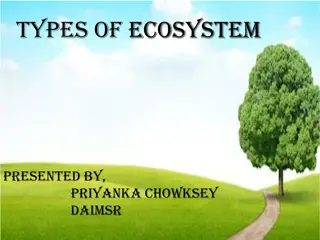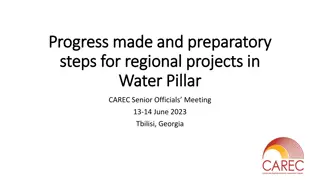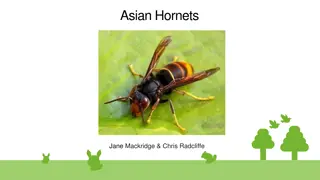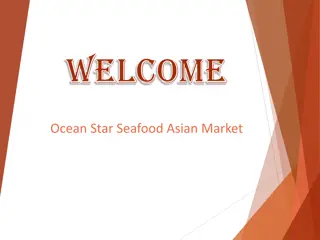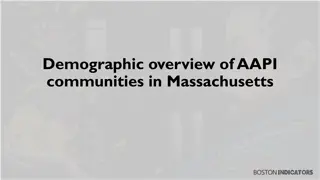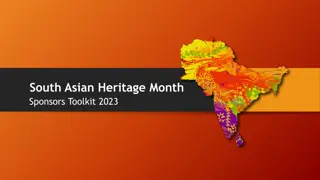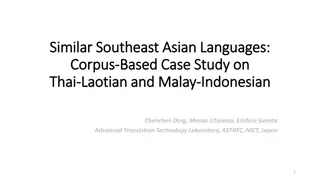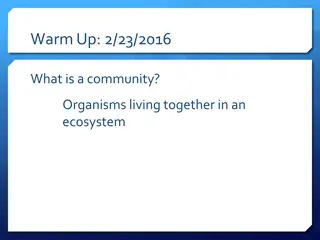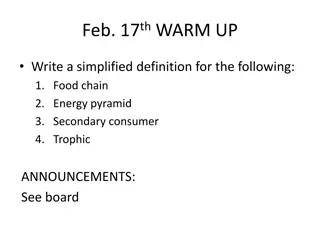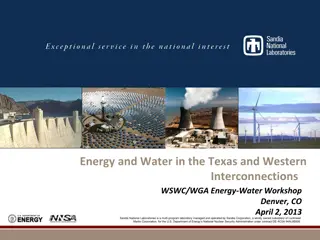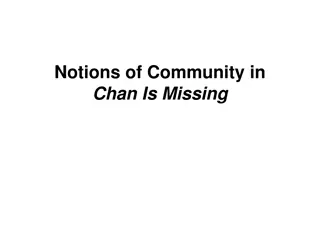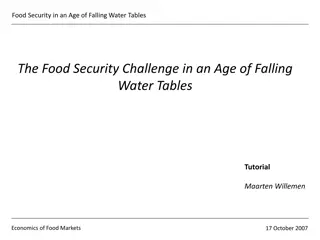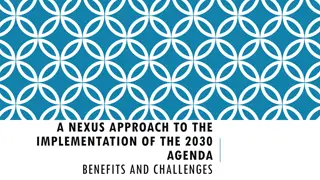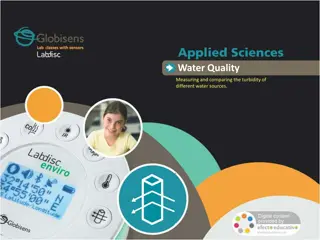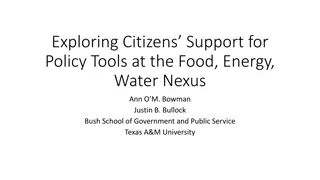Lessons from Water-Food-Energy-Ecosystem Nexus at Central Asian Environmental Forum
Explore insights from assessing the water-food-energy-ecosystems nexus discussed at the Central Asian Environmental Forum. Mr. Peep Mardiste shares approaches, findings, and potential response actions. The UNECE Water Convention's framework, tools, and methodologies for assessing nexus relationships are highlighted, emphasizing the importance of intersectoral synergies, transboundary cooperation, and data-driven analysis.
Download Presentation

Please find below an Image/Link to download the presentation.
The content on the website is provided AS IS for your information and personal use only. It may not be sold, licensed, or shared on other websites without obtaining consent from the author.If you encounter any issues during the download, it is possible that the publisher has removed the file from their server.
You are allowed to download the files provided on this website for personal or commercial use, subject to the condition that they are used lawfully. All files are the property of their respective owners.
The content on the website is provided AS IS for your information and personal use only. It may not be sold, licensed, or shared on other websites without obtaining consent from the author.
E N D
Presentation Transcript
Side event 5 Central Asian Environmental Forum Ashgabat, 7 June 2017 Lessons learned from assessing the water-food-energy-ecosystems nexus: approaches, findings and possible response actions Mr. Peep Mardiste Regional coordinator EUWI National Policy Dialogues UNECE
Nexus assessments under the UNECE Water Convention: the framework, 1/2 A part of the Programme of Work 2013-2015 under the UNECE Water Convention (a global instrument); continues 2016-2018; Assessed: Alazani/Ganykh, Sava, Syr Darya, Isonzo/Soca; Drina; starting North-Western Sahara Aquifer
Nexus assessments under the UNECE Water Convention: the framework, 2/2 Task Force on the Water-Food- Energy-Ecosystems Nexus established to guide the work and to provide oversight; close cooperation with the Sustainable Energy Division Aims: Foster transboundary cooperation (intersectoral synergies & measures to reduce tensions); assist countries (resource use optimization, capacity building); ENERGY CLIMATE and ENVIRONMENT ECOSYSTEM SERVICES assessments prepared in close cooperation with and reviewed by the national administrations; Meeting of the Parties endorsed the methodology and general conclusions (November 2015) FOOD/LAND WATER
Types of tools and approaches to analysing intersectoral issues 1. 2. 3. 4. 5. Considerations: Result of the nexus assessment may be controversial to a sector or a country; the design of the process is important to ensure acceptance An active participation and commitment from the countries necessary to shape the process into a valuable exercise, focusing on relevant policy issues Ensuring a sufficiently broad participation of other sectors is challenging Even though already the intersectoral-transboundary dialogue has value, adequate data is necessary for a meaningful analysis The tools need to be fit-for-purpose, selected to the scale of the analysis and the issues at stake Dialogues Mapping of interactions between sectors Multiple resource scenarios Extended systems analysis Institutional analysis
Nexus assessment methodology developed under the Water Convention Provides for participatory intersectoral assessment at transboundary level informed by analysis, prepared in close cooperation with national governments Adapts to the context and the issues specific to the basin Applicable to surface water basins and aquifers
Main categories of solutions The Water Convention s nexus approach non-prescriptive, inclusive and indicative provides a good basis for identification of cooperation opportunities Institutions (intersectoral, multiple level governance, engaging resource users, responsibilities etc.) Information (multi-sector information to support policy, assessing impacts across sectors, guidelines etc.) Instruments (economic instruments, SEA etc.) Infrastructure (built and natural investments, operation, multiple use designs etc.) International coordination and cooperation (sharing information, plans, good practices etc.)
Nexus opportunities in different basins vary (examples with energy focus) Isonzo/ So a Sava Alazani/Ganykh Syr Darya Link RES generation to existing agriculture infrastructure (small hydropower, solar, biomass); improve river continuity and increase drought resilience Develop hydropower sustainably and integrate other renewable energies Facilitate access to modern energy sources and energy trade; minimize impacts from new hydropower development; catchment management to control erosion Promote restoring and vitalizing energy market, develop the currently minimal trade in agricultural products; improve efficiency in energy generation, transmission and use; improve efficiency in water use (esp. in agriculture)
Possible solutions/synergic actions identified in the Syr Darya basin (selected) 1. National development with co-benefits Improving energy efficiency, reducing dependency on water for energy (diversification of sources) Rationalizing water use (esp. in agriculture) 2. Broader sustainable development and national policy coherence Developing mechanisms to identify and incorporate the wider nexus impacts in sector-based policy development leading to more integrated planning processes Improving basin-wide monitoring, data verification and exchange, and knowledge-sharing, including joint monitoring (e.g. water flows and quality), joint forecasting 3. Accelerate national development by furthering cooperation Improving intersectoral coordination at the basin level by increasing representation of and consultation with the relevant ministries Developing a regional energy market and exploring opportunities for energy- water exchanges
Benefits of transboundary cooperation in the management of resources of the Syr Darya basin
Some insights for advancing nexus thinking in Central Asia The nexus approach should build on the existing e.g. multisector structures, intersectoral processes (such as EUWI National Policy Dialogues), review policy and economic instruments, consultation on and coordination of investments Ensuring a sufficiently broad participation of different sectors in a dialogue is necessary. How to find the common interest(s)? With water as the only entry point risks blocking because getting fixed on (by default conflictual) water allocation. Energy (beyond hydro) and trade could offer constructive perspectives Perceptions about the nexus/nexi vary. The complex issues require clear and accessible communication Achieving Sustainable Development Goals (food security, water, energy etc.) will require taking into account intersector effects: Can this motivate action? In the nexus assessments under the Water Convention, a methodology has been applied, an identification of issues and some solutions made jointly, and a model developed of the national energy systems to run scenarios can serve further work and awareness raising
Some perspective areas for further work Documentation (reports, analysis, briefs) from the UNECE nexus work can substantiate the dialogue and contribute to capacity building In-depth assessments of governance across sectors at the national level would be valuable, as well as a review of how selected intersectoral processes (e.g. SEA) are applied or what the perspectives for their use are in the countries Carry out an assessment of available water resources, saved water, water and land productivity, including a critical descriptive and quantitative analysis of the potential effect of measures in improving efficiency of irrigation and improvement of land reclamation. To complement the energy analysis done; the model can be used to assess impacts of some investments. Evaluate costs and benefits of selected nexus solutions prioritized by the countries Fora for awareness raising, capacity building, sharing experience, extending the dialogue: EUWI National Policy Dialogues, SPECA Thematic Working Group etc. Facilitation of bankable projects. In renewable energy, UNECE Group of Experts on Renewable Energy) is promoting this in a session at the Forum on Energy for Sustainable Development in Astana (11-14 June 2017)




